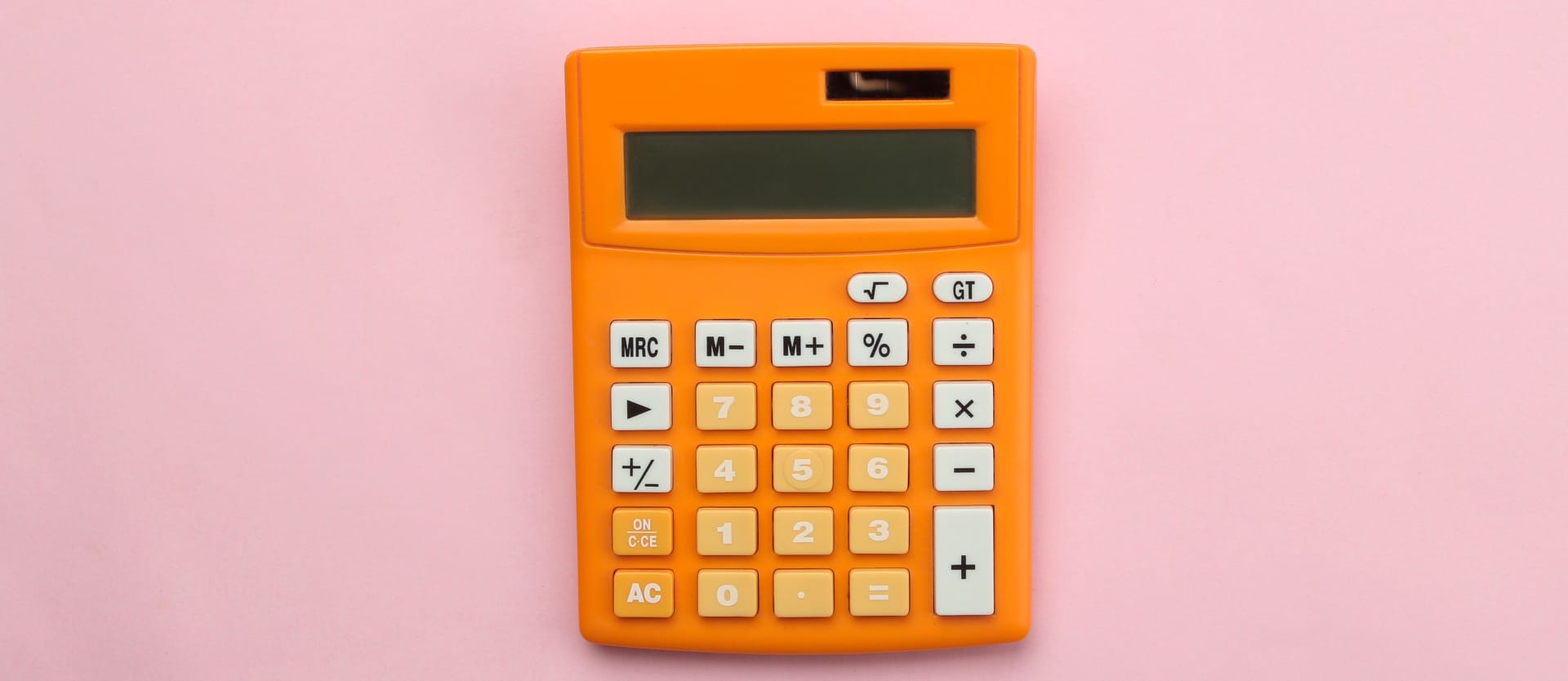There exists a common consensus that if you’re not using dynamic pricing, you’re leaving money on the table. If you’re reading this, you probably think the same. Truly, one of the main principles of revenue growth is selling your product for the highest possible price people will buy it. For the hotel business, it’s especially relevant since you lose money on every unbooked room. You need every bit of revenue you can get and static prices just don’t cut it.
In this article, we’ll cover and compare different approaches to dynamic pricing as well as some popular tools to help you improve your pricing strategy.
What is dynamic pricing? Static vs dynamic rates
Dynamic pricing is simply the practice of changing the price of a product or service based on current market conditions.
Unlike static prices, which are set at a fixed amount and change only annually or seasonably, dynamic rates adjust in real time depending on demand, booking patterns, competitor prices, time of booking, and availability. They can alter every day or even every hour and can also be different for each particular guest.
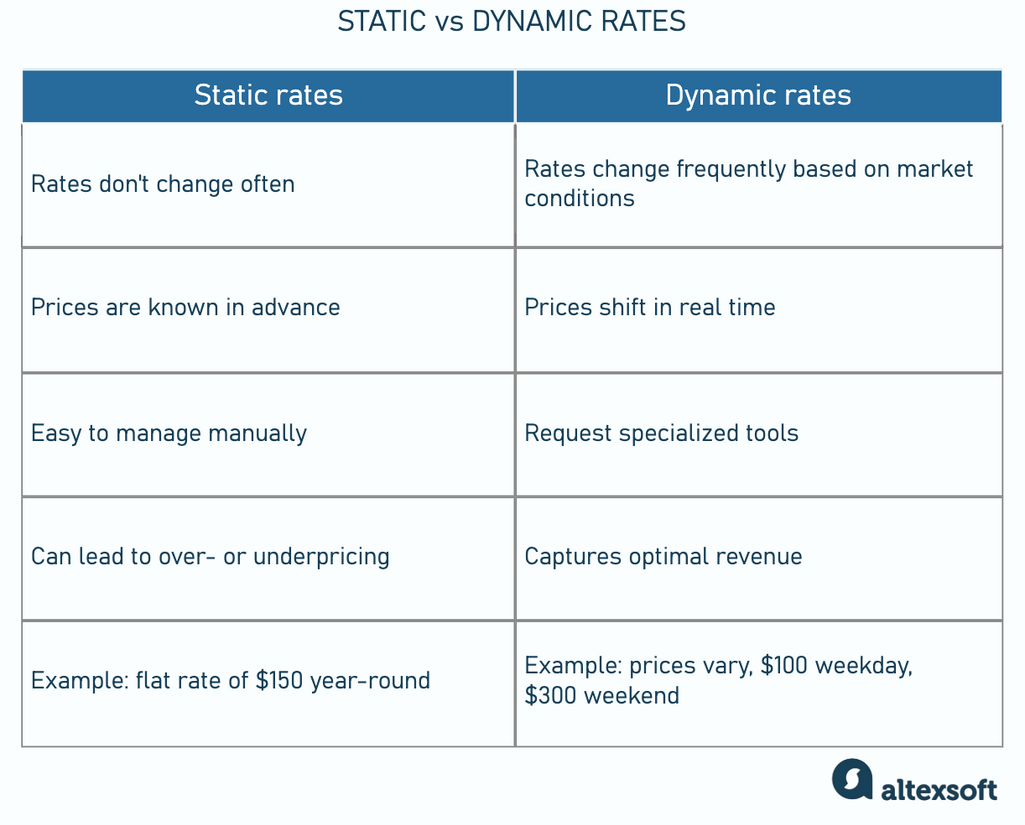
Comparing different types of rates in hotels
Dynamic pricing has become a natural outcome of the trend for revenue management optimization and profit maximization in the hospitality industry, specifically as a result of the pandemic.
The industry was also forced to start innovating by developing new sources of revenue, improving efficiencies, while at the same time, it also incurred additional costs related to employee and guest health concerns. Hence, hotel revenue levels and structure, as well as expense levels and structure, have drastically changed for many businesses.
So, price variation has become the norm, helping businesses maximize revenues and survive the pandemic and recessions. For that, they need to understand and predict fluctuations in guest behavior and market demand in real time.
For example, if you own a bookshop and you don’t sell many books today, you can just sell them tomorrow, not a big deal! At the same time, if you sell out of some international bestseller, you can simply order more copies and keep selling those, taking advantage of high demand. You might lower the price for some unpopular books eventually, but you certainly won’t be making those changes every day.
Hotels, though, have to make the most out of every night because of two conditions:
- Hotel rooms are perishable, meaning that every night a room is not booked, you lose the revenue opportunity, since it takes money to maintain the rooms anyway.
- Hotel rooms are limited since you can’t simply increase the number of rooms to accommodate larger demand.
But before we go further, we want to talk more about benefits and unseen risks with adopting dynamic pricing.
Dynamic pricing benefits and risks
Okay, so the advantages of dynamic prices over static ones are obvious – you will be earning more. Let’s quickly go over things that will become possible and available to you with dynamic pricing.
You will be able to maximize your RevPAR. Revenue per available room is one of the main metrics of a hotel’s performance which shows how well the business fills its rooms and how effective its pricing strategy is. Since dynamic pricing allows hotels to set rates that align with market conditions, hotels can fill more rooms and charge the best possible price at any given time, thus increasing RevPAR.
You will be able to prepare for the future. If you’re using data-driven dynamic pricing, you will operate based on both historical and current booking data to anticipate low and high demand periods. This will allow you to make better strategic decisions — like when to launch promotions or how to adjust marketing efforts. Not even mentioning that better demand forecasting can help you optimize staff scheduling, inventory management and other operational aspects of your business.
You will be able to deliver targeted offers. By analyzing guest profile data, you can segment customers and offer tailored prices, whether they’re leisure or business travelers or last-minute bookers.
Now, before we go any further, you must know of the potential drawbacks that dynamic pricing comes with.
Negative customer perception
Just in 2024 hotel prices soared in the cities visited by Taylor Swift on her worldwide tour. Fans were forced to pay inflated accommodation prices if they were visiting from another location, and even regular travelers and tourists had no choice but to overpay if they were targeting the same dates. Many reported that their stays booked for original rates were canceled by hotels who wanted to sell them for quadruple prices.
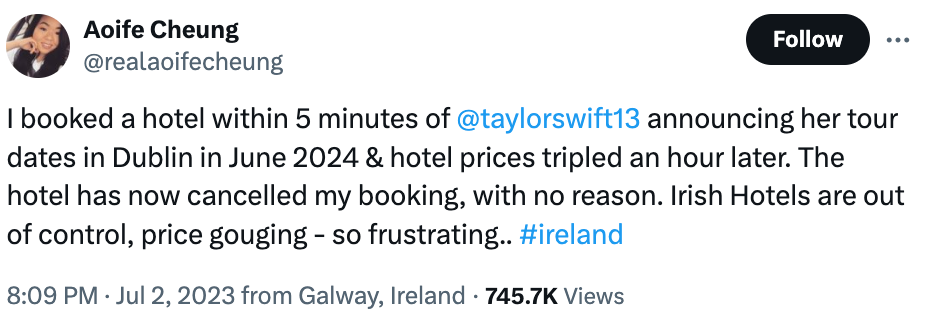
Changing your prices due to demand is one thing, but canceling your guests’ bookings is another. Source: @realaoifecheung
This, of course, has led to even more public outrage about “surge pricing”, considered by many an unfair and exploitative tactic.
What this could mean to you as a hotel is that your customers can be frustrated by constant fluctuations in pricing and might feel overcharged if you drop the price after they’ve already booked. A certain number of negative reviews could be a blow to your reputation and brand loyalty.
There are ways to prevent this though. Our colleagues at Harvard Business Review offered a few tips on communicating dynamic pricing so it doesn’t alienate your audience. In short, you must be open and somewhat generous with your customers, sharing with them incentives and purchasing tips, so they feel like the system works for them too.
Price wars
Transparent pricing is an important trait of the market, allowing customers to compare rates from different merchants before they find the best one. This means that businesses aggressively cut prices to win the competition, and when the whole market does the same, the profit margin reduces all over.
For example, that’s what happened in the late 2000s between Travelodge and Premier Inn – rival British budget hotels. When Travelodge cut its prices to £29 a night, Premier Inn promoted the same price in their Christmas campaign, leading to a formal complaint by Travelodge to the Advertising Standards Authority. They later rolled out their own price comparison ad.
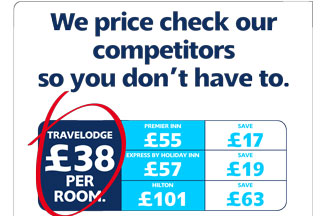
Price comparison ads tend to reduce competition to just a numbers game. Source: Campaign
The intense competition stifled after that, forcing both brands to focus on upselling additional vertices and improving brand loyalty programs to increase the margins instead.
So, the real danger lies in not thinking about your pricing strategically and simply reacting to the competitors. As long as you take your time studying competitor pricing without any knee-jerk reactions and stick to your own thought-out pricing strategy, you’ll be fine.
Technological and data complexity
Dynamic pricing functionality can be achieved via special software, which requires investment in technology and relies on large volumes of accurate data. This software, which is often a full-fledged revenue management system, should be properly integrated with your existing tools and maintained. And that’s not including skilled personnel who can set up the infrastructure for you and keep it running.
And if you’re using ML-based dynamic pricing, which we’ll talk about in the following sections, you will need to source and clean a lot of data to feed the model and reveal demand and booking patterns. This again incurs additional costs for data expertise and infrastructure.
There are simpler methods at achieving dynamic pricing, but they come with limitations, so you should consider how much you’re willing to invest before committing to this process. Which is our next topic of discussion.
Types of dynamic pricing
There are two main strategies to dynamic pricing that hotels employ. Both take into account market conditions, like demand, seasonality and location popularity, but the difference lies in the flexibility of your rate fluctuations and the number of factors taken into account.
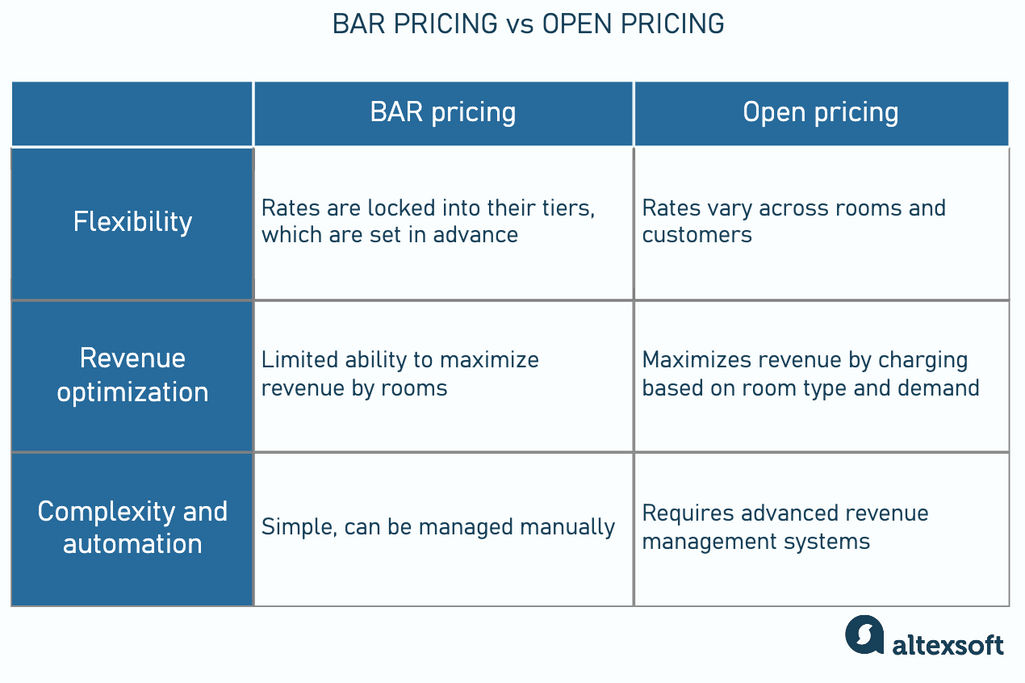
Main differences between BAR and open pricing
Let’s first look at a more traditional type – the Best Available Rate pricing.
Best Available Rate pricing
BAR (Best Available Rate) refers to the lowest rate a hotel offers for a specific room type. A BAR rate can change depending on the day of the week or time of the year, but it usually guarantees that it’s the best possible price one can get for this particular room at this particular time. A BAR can be combined with other offers, like business rates or loyalty discounts. Here’s how it works.
Say, you’re a revenue manager at a Lotus Hotel somewhere on the Italian coastline. You will need to set up BARs for different rooms. So, you have BAR 1 for low demand periods like weekdays that will be $150, BAR 2 for high demand periods like holidays and weekends that will be $200, and BAR 3 for special event days like concerts and festivals – $250.
You also use modifiers — for example, if you offer a sea view room, it can add $75 to your BARs. And you can apply discounts, too. Corporate clients might get 15 percent off any BAR, or a sale through a certain channel, like a hotel website or a mobile app, will have a pre-set discount as well.
BARs and modifiers are predefined. See, it’s like having a finite number of price tags or discount vouchers in your store that you can change from time to time, but you can only choose among the ones you already have. This means a few things.
Channel lock. What if you have a predefined discount for a particular OTA of a whopping 20 percent? This is fine on normal dates, but if the demand is high and the sales are big, you wouldn’t want to lose revenue to this channel, so you just switch it off to force people to book directly or on more lucrative channels.
Non-granular price points. Imagine that you only have $200 and $300 price tags. Selling a room for $200 is too cheap for you, so you set up a $300 price. But there comes a customer who can’t afford a $300 room, but would pay $250. Problem is – you don’t even have a BAR with that number, so you end up losing the sale.
Basically, the prices fluctuate only in relation to the BARs you set. That’s why today a more advanced method to dynamic pricing is promoted.
Open pricing
The main difference of the open pricing approach from BAR is that you can adjust the price of each room, package or service independently and take into account individual customer preferences as well.
Let’s say there’s a festival happening in our Italian coastal town. How would the Lotus Hotel price its rooms using both BAR and open pricing methods?
Festival pricing under BAR would be:
- $300 for standard room types
- $500 for deluxe and suite
- +$75 for ocean view
- -20 percent discount for Agoda
- -15 percent discount for corporate channel
But with open pricing, the hotel can adjust much better:
- From $250 to $400 for standard room types
- From $450 to $650 for deluxe and suite
- From +$40 to +$100 for ocean view
- From -1% to -20% for Agoda
- From -1% to -15% for corporate channel
See, regardless of the fact that the base prices lowered, the hotel can now capture a much bigger crowd of diverse guests, fill its rooms, and capitalize on clients that are willing to pay more. You also don’t need to close a channel or stop a promotion for corporate clients, but can adjust the amount to how you see fit.
So how does it work? Well, mostly thanks to analytics and forecasting.
Dynamic pricing methods
Dynamic pricing systems in hotels can work using the following two methods.
One is the rule-based system. Rules basically follow the “if-then” logic, allowing you to program specific actions whenever software detects a certain condition.
Rules are written by revenue managers based on statistical models or simply what they know might happen. Say, if you want the prices to grow when demand increases, you might set up the following rule:
If 70 percent of the rooms are booked, the price for the remaining rooms automatically increases by $25.
Or if you want to apply a rule for specific lead times, it might look like this:
If the booking is made more than 30 days in advance, apply a 10 percent early-bird discount.
A rule-based revenue management system will store dozens if not hundreds of such rules for every possible scenario, which will allow you to automate price adjustments.
But there’s one important fault of this method, which is derived from the limitations of statistical models: the system won’t be precise enough to capture how a combination of many different factors (weather+concert+high season+travel restrictions+etc.) will impact the demand, and calculate just the right price that will increase the revenue and doesn’t alienate customers.
This is where we arrive at machine learning (ML).
The main benefit of machine learning models over statistical ones is that it can tap into vast amounts of data, find hidden patterns in it, and understand which parameters impact the demand the most.
Say, a statistical model may come to a conclusion that the day of the week matters more than the weather, so weekend prices must remain high regardless of the promised heat wave.
But only ML could discover that although weekends are typically busy, demand actually drops if a neighboring city hosts a major event that diverts travelers away. It could also identify patterns that aren't obvious, such as how certain guest segments (such as last-minute bookers or loyalty program members) might be more responsive to weather changes than others. And it will use all this confusing data to decide on the most optimal price.
For example, how do you decide what prices you should establish months in advance to the actual check-in? To answer this question, we built a revenue optimization algorithm for our client Rakuten Travel. We used the company’s historical data as well as data from their direct competitors to train the model, which can now predict occupancy based on many factors, including, of course, rates set by competitors.
Similarly, the occupancy prediction feature that we developed for KeyData was trained on historical data with 120,000 series for properties and 20,000 series for areas to accurately forecast occupancy in rentals for an upcoming month.
But this level of detail and flexibility does come with a price. An ML system will have higher initial cost and require complex implementation with the rest of the hotel’s software.
This doesn’t mean that ML will completely replace revenue managers. Human judgment and strategic oversight are still needed when it comes to big-picture decisions and making sure that strategies offered by software align with business goals. Besides, there will be times when the hotel will be running special promotions or discounts, and the revenue manager will need to add those rules.
So, since we know about the types of solutions, let’s review some popular ones.
Dynamic pricing tools
Both rule-based and ML-based software is currently used by hotels and they can be independent or exist as a feature in revenue management (RM) systems. Here we want to talk about a few popular options that you might want to consider.
Important: we’re not endorsing any of these tools and use them simply as examples for illustrative purposes.
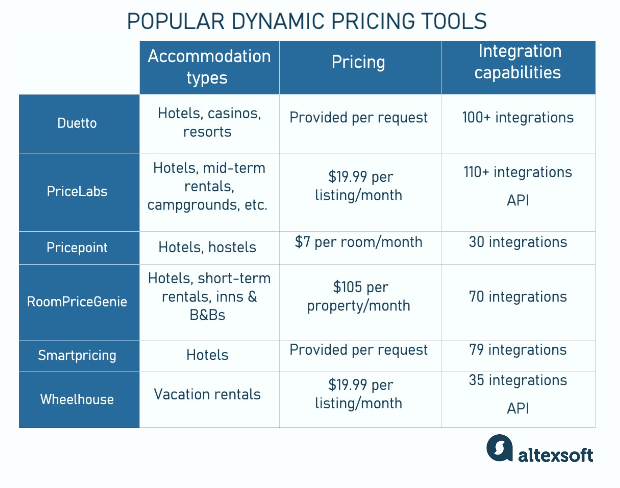
Comparing popular dynamic pricing software
You will notice that most of them are using a combination of machine learning and rules, which will allow you to put the system on autopilot but chime in from time to time. You can review the features in more detail to pick the level of customization which suits you best. Apart from method and pricing, take into account the following factors.
Industry. If you’re a smaller hotel, a vacation rental manager, a resort, or any other alternative accommodation provider, look for vendors that have such businesses in their portfolio. This is especially important when you lack historical data because you will have to rely on the provider’s dataset for predictions in that case.
Integration capabilities. Typically, such tools already provide direct integration with popular property management systems (PMS) and channel managers. So, if you’re using Cloudbeds or Apaleo, look for them in the list of supported providers. But if you’re using your own custom PMS, you will need integration via API, which makes connectivity fairly easy to establish.
Duetto
Duetto is a revenue management system targeted towards hotels, casinos, and resorts. It uses predictive analytics and open pricing to keep rooms optimally priced each day. Duetto generates projections for up to 5 years into the future based on historical data, current booking trends, and external market conditions.
It predicts occupancy rates, demand peaks, and downturns, enabling better pricing and inventory decisions. Hotels can adjust or override recommendations based on specific business needs, promotions, or brand strategy.
Hotels that cater to group bookings can use Duetto to optimize group pricing. The system suggests group rates that balance the need for filling inventory with maximizing profitability. It also helps forecast group business trends and demand.
Duetto has over 100 integrations, including PMSs, booking engines, channel managers, rate shopping tools and more. Their pricing is undisclosed.
PriceLabs
PriceLabs is a versatile dynamic pricing and revenue management tool that uses data and machine learning to make pricing recommendations. Its algorithm leverages data from Airbnb, Vrbo, and Booking.com as well as your own historical performance and booking data to detect market trends and give recommendations for each night. You can also override its recommended prices and set up your own discounts and pricing rules.
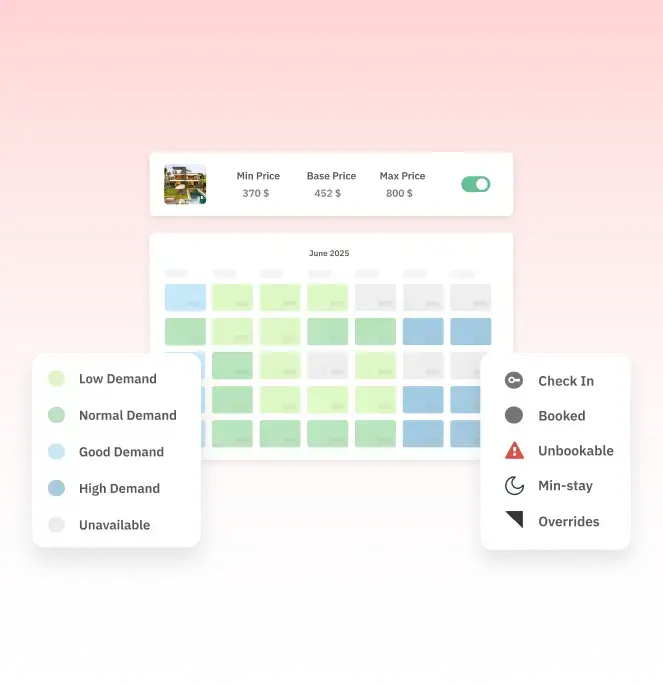
What you can expect from a price calendar from PriceLabs. Source: PriceLabs
You can sync it to a variety of property management systems and channel managers, as well as set up your own API connection. The cost starts at $19.99 per month per property and there’s a 30-day free trial.
Pricepoint
Pricepoint is another RMS, which uses an AI-powered pricing engine. It creates demand forecasts by running simulations and updates prices automatically whenever there’s a change. It can work with its own dataset, but recommends getting at least two years of historic data from your PMS for better predictions. On top of that, it uses current trends, events, and weather, and keeps updating its forecast with every new piece of data.
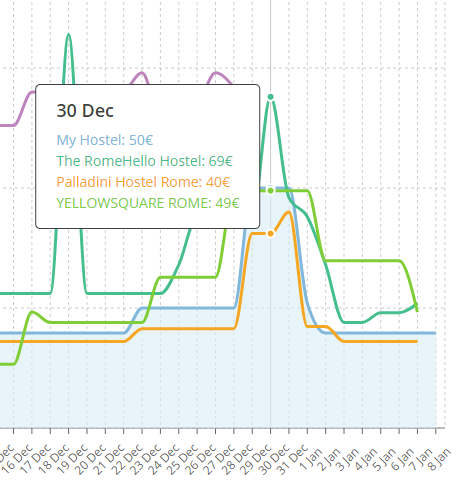
Comparing competitor pricing is one of the crucial steps in setting your own. Source: Pricepoint
Pricepount has a separate RMS product for hostels, which has the same AI-driven dynamic pricing functionality.
Pricepoint integrates with 30 PMSs and channel managers, is priced at $7 per room monthly and has a 30-day free trial. For hostels, the rate is $130 per month.
RoomPriceGenie
RoomPriceGenie is a revenue management system that monitors prices of your competitors, seasonality, and your own booking patterns to determine the right price and make adjustments. It doesn’t change prices automatically unless you turn the autopilot feature on, which is when the system calculates and updates rates independently.
Among some of its unique features is surge protection. There’s a model that triggers after you experience a significant increase in bookings to alert you about the surged demand
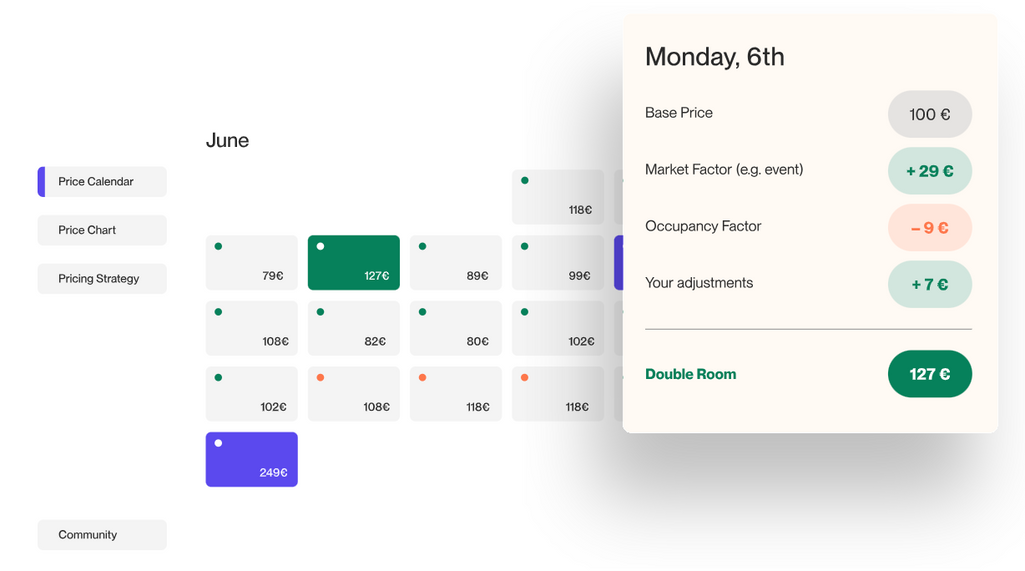
You can see a breakdown of a price when you choose a particular date. Source: RoomPriceGenie
RoomPriceGenie pricing starts at €95 ($105) per property per month since it’s positioned as a full-fledged RMS, but the full list of features unlocked with higher tiers. There’s a 14-day trial period.
Smartpricing
Smartpricing is an AI-driven RMS that takes into account your rules and price limits. It also provides justification for price changes. If there’s an event the algorithm didn’t take into account, you can create one in the calendar and assign the level of impact this event might have on demand.
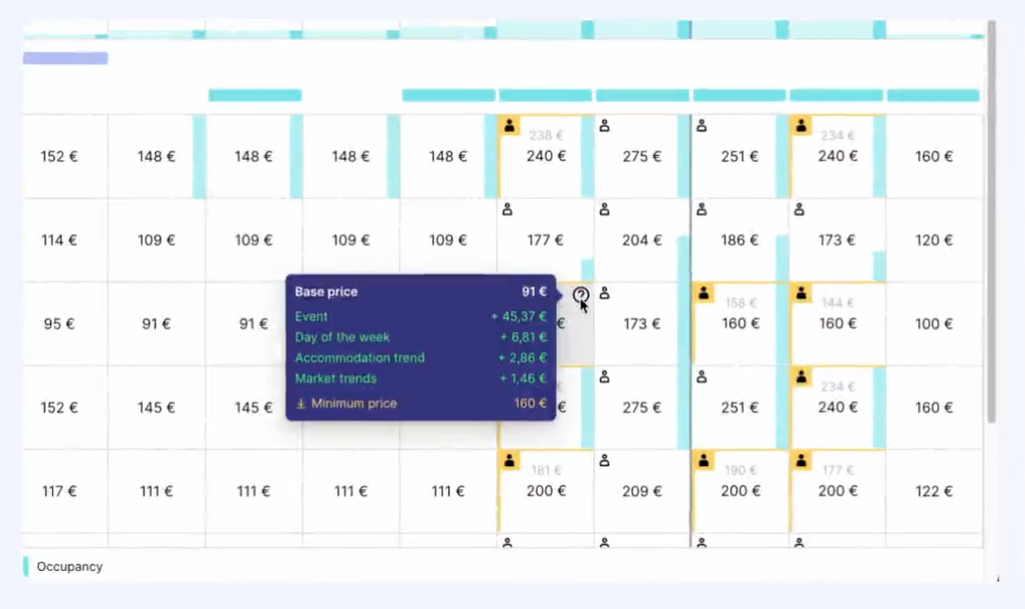
Another interpretation of a price calendar. Source: Smartpricing
Smartpricing integrates with a wide range of PMSs, channel managers and other types of systems. The company provides its pricing upon request, after learning about your business.
Wheelhouse
Wheelhouse is a dynamic pricing software specifically for short-term and vacation rentals. They offer two products: Dynamic Pricing and Dynamic Sets.
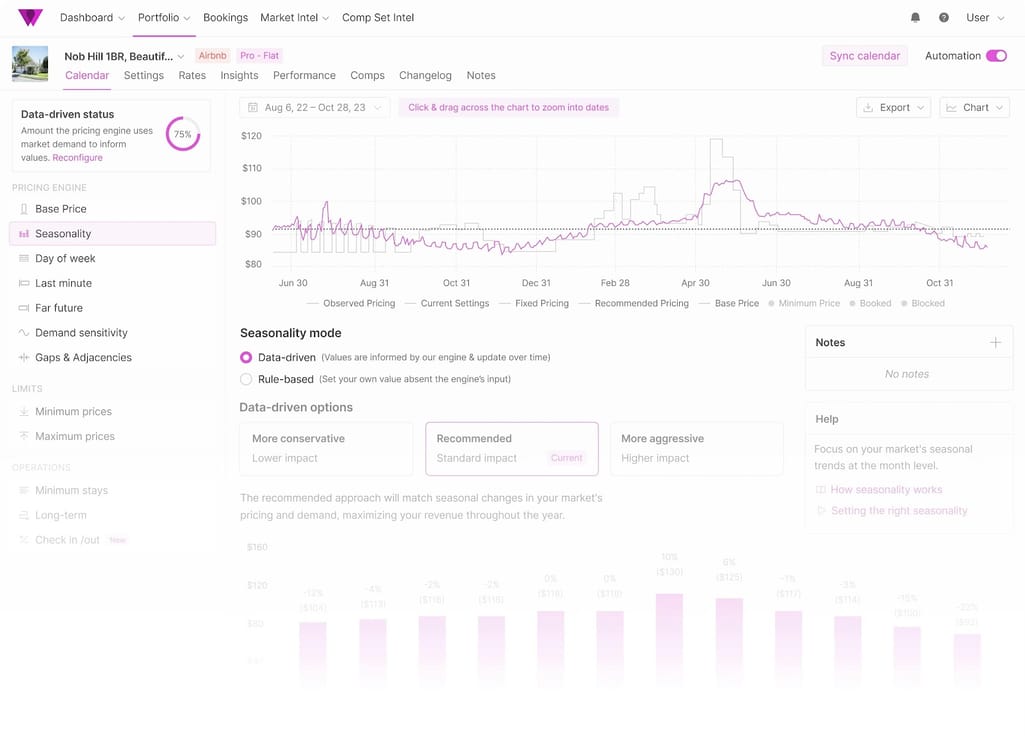
Wheelhouse has a very detailed dashboard to review your price strategy at a glance. Source: Wheelhouse
Dynamic Pricing allows you to use rule-based and data-driven approaches separately, as well as a hybrid of both, allowing you to customize every little aspect of your pricing strategy and gain recommendations from their pricing engine.
At the same time, Dynamic Sets is marketed towards more complex hospitality landscapes and allows you to compile your properties into collections based on tons of different factors, which can then be used to optimize pricing, benchmark performance, and more.
Wheelhouse provides integrations to a few popular vacation rental management tools, channel managers and channels, such as Airbnb and TripAdvisor. There’s also an API, which you can connect to your own website or booking system and gain pricing recommendations. There are different pricing plans, starting at $19.99 per listing per month for the Dynamic Pricing product.
How to approach dynamic pricing
So, you want to switch to dynamic pricing? Great news and hopefully a decision that will bring your business even more success. Although most software vendors offer to do the job for you and seamlessly integrate with your system to get dynamic pricing running, this doesn’t mean that you don’t need to prepare. Here are a few of our recommendations for your next steps.
Collect historical booking data. You probably already store information about your past bookings somewhere. Be it in an Excel document or a PMS, this data will drive the prediction algorithm, shaping it according to the customer behavior and booking patterns prevalent just for you. At least 2-4 years of these records will be a great start. Learn when this data resides and maybe even start the dataset preparation process.
Educate your team. A simple solution would be to employ a revenue manager, if you don’t currently have one, but it’s not always an option. So, someone from your team will need to learn not only to operate dynamic pricing tools, but also understand revenue management and pricing optimization. This might be quite a bit of a mindset shift if you’ve been using static pricing for years prior.
Experiment with software. Use one of the tools on the market to help you make pricing decisions, track your occupancy, and adjust rates using the tool’s recommendations. Learn more about demand in different periods and areas, get to know your competitors and customers, and keep record of your booking data and occupancy while using dynamic pricing. You may stop here and rely on those tools for your revenue management needs, or you may go further.
Try creating a custom model. You can always gain more if you go your own route and build a rate optimization feature yourself. As our experience indicates, custom development allows you to fix any problems you might have with ready-made tools and target very specific tasks that require a personalized approach. You will need some time and resources, as well as a year or two of historical data and a reliable tech partner.
We hope this article cleared this topic for you and inspired you to take advantage of technology. You can find more content about price optimization in our blog.

Maryna is a passionate writer with a talent for simplifying complex topics for readers of all backgrounds. With 7 years of experience writing about travel technology, she is well-versed in the field. Outside of her professional writing, she enjoys reading, video games, and fashion.
Want to write an article for our blog? Read our requirements and guidelines to become a contributor.
